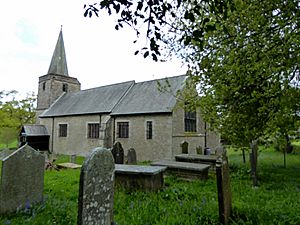St Peter's Church, Leck facts for kids
Quick facts for kids St Peter's Church, Leck |
|
|---|---|

St Peter's Church, Leck, from the northwest
|
|
| Lua error in Module:Location_map at line 420: attempt to index field 'wikibase' (a nil value). | |
| OS grid reference | SD 643,766 |
| Location | Leck, Lancashire |
| Country | England |
| Denomination | Anglican |
| Website | St Peter, Leck |
| History | |
| Status | Parish church |
| Architecture | |
| Functional status | Active |
| Heritage designation | Grade II |
| Designated | 4 December 1985 |
| Architect(s) | Paley and Austin (1878–79) Austin, Paley and Austin (1915 rebuilding) |
| Architectural type | Church |
| Style | Gothic Revival |
| Specifications | |
| Materials | Sandstone, slate roofs |
| Administration | |
| Parish | Tunstall, Melling and Leck |
| Deanery | Tunstall |
| Archdeaconry | Lancaster |
| Diocese | Blackburn |
| Province | York |
St Peter's Church is a beautiful old church located in the small village of Leck, in Lancashire, England. It's an active Anglican parish church, meaning it's a local church for the community. It belongs to the Diocese of Blackburn.
St Peter's Church is part of a group of churches in the East Lonsdale area. This group includes St Wilfrid's in Melling and St John the Baptist's in Tunstall. The church is also recognized as a Grade II listed building, which means it's an important historical building that needs to be protected.
Contents
History of St Peter's Church
Early Buildings and Changes
The very first church on this spot was built a long time ago, in 1610. It was a small, one-story building. Later, in 1825, the church was made bigger, and a small tower was added to it.
Building the Current Church
The church you see today was built between 1878 and 1879. It was designed by famous architects from Lancaster, called Paley and Austin. Building this church cost about £3,000 back then, which was a lot of money! It was designed to have seats for 224 people.
Fire and Rebuilding
In October 1913, the church was badly damaged by a fire. But don't worry, it was rebuilt by 1915. The rebuilding cost around £5,000. The new church was built to look exactly like the original design. It was done by Austin, Paley and Austin, who took over the original architectural firm.
Architecture of the Church
Outside the Church
The church is built from sandstone rubble, which means it uses rough, uneven pieces of stone. The roof is made of slate. The church's layout includes a main area called the nave, with a north aisle (a side section). There's also a wooden porch on the south side.
At the front, there's a chancel, which is the part of the church where the altar is, and it's a bit lower than the nave. On the north side of the chancel, there's a vestry, which is a room used by the clergy. The church also has a tall west tower.
The tower has two main parts and is topped with a flat wall called a parapet and an eight-sided spire made of slate. The bottom part of the tower has a large window with three sections. This window features a special kind of stone pattern called Perpendicular tracery. The top part of the tower has single openings for the bells. Along the south wall of the nave, there are windows with four sections, and the chancel has windows with three and one section. The large window at the east end of the church has eight sections.
Inside the Church
Inside St Peter's Church, a series of five arches, called an arcade, separates the main nave from the north aisle. The timber roof inside is open, showing the wooden beams. The font, which is used for baptisms, is made of sandstone and has eight sides.
Many of the beautiful stained glass windows survived the fire. They were put back into place by a company called Powells, who used the original drawings by an artist named Henry Holiday. The church's first organ was built between 1850 and 1881 by Henry Jones. The current organ, which has two keyboards (called manuals), was built in 1915 by Harrison & Harrison. The church also has a set of five bells, all made in 1914 by John Taylor & Co.
Churchyard Features
In the churchyard, you can find some old "fever graves" from the 1800s. These are the graves of three girls who died from a fever at the Clergy Daughters' School in Cowan Bridge. There is also a war grave for an airman from the Royal Air Force who died during World War II.
Gallery
See also
- Listed buildings in Leck, Lancashire
- List of ecclesiastical works by Paley and Austin
- List of works by Austin, Paley and Austin







